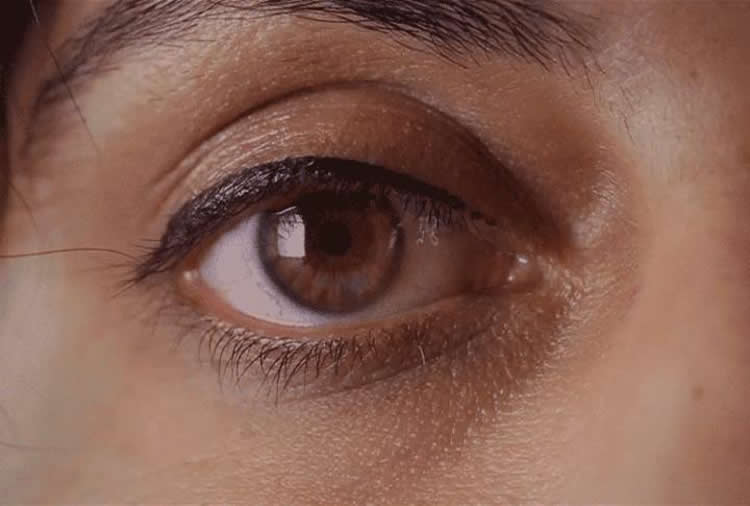Summary: Our brains reposition our eyeballs as we blink in order to allow us to stay focused on what we are looking at, a new study reports.
Source: UC Berkeley.
Study finds that blinking prompts eye muscles to keep our vision in line.
Every few seconds, our eyelids automatically shutter and our eyeballs roll back in their sockets. So why doesn’t blinking plunge us into intermittent darkness and light? New research led by the University of California, Berkeley, shows that the brain works extra hard to stabilize our vision despite our fluttering eyes.
Scientists at UC Berkeley, Nanyang Technological University in Singapore, Université Paris Descartes and Dartmouth College have found that blinking does more than lubricate dry eyes and protect them from irritants. In a study published in today’s online edition of the journal Current Biology, they found that when we blink, our brain repositions our eyeballs so we can stay focused on what we’re viewing.
When our eyeballs roll back in their sockets during a blink, they don’t always return to the same spot when we reopen our eyes. This misalignment prompts the brain to activate the eye muscles to realign our vision, said study lead author Gerrit Maus, an assistant professor of psychology at Nanyang Technological University in Singapore. He launched the study as a postdoctoral fellow in UC Berkeley’s Whitney Laboratory for Perception and Action.
“Our eye muscles are quite sluggish and imprecise, so the brain needs to constantly adapt its motor signals to make sure our eyes are pointing where they’re supposed to,” Maus said. “Our findings suggest that the brain gauges the difference in what we see before and after a blink, and commands the eye muscles to make the needed corrections.”
From a big-picture perspective, if we didn’t possess this powerful oculomotor mechanism, particularly when blinking, our surroundings would appear shadowy, erratic and jittery, researchers said.
“We perceive coherence and not transient blindness because the brain connects the dots for us,” said study co-author David Whitney, a psychology professor at UC Berkeley.
“Our brains do a lot of prediction to compensate for how we move around in the world,” said co-author Patrick Cavanagh, a professor of psychological and brain sciences at Dartmouth College. “It’s like a steadicam of the mind.”

A dozen healthy young adults participated in what Maus jokingly called “the most boring experiment ever.” Study participants sat in a dark room for long periods staring at a dot on a screen while infrared cameras tracked their eye movements and eye blinks in real time.
Every time they blinked, the dot was moved one centimeter to the right. While participants failed to notice the subtle shift, the brain’s oculomotor system registered the movement and learned to reposition the line of vision squarely on the dot.
After 30 or so blink-synchronized dot movements, participants’ eyes adjusted during each blink and shifted automatically to the spot where they predicted the dot to be.
“Even though participants did not consciously register that the dot had moved, their brains did, and adjusted with the corrective eye movement,” Maus said. “These findings add to our understanding of how the brain constantly adapts to changes, commanding our muscles to correct for errors in our bodies’ own hardware.”
In addition to Maus, Whitney and Cavanagh, co-authors of the study are Marianne Duyck, Matteo Lisi and Therese Collins of the Université Paris Descartes.
Source: Yasmin Anwar – UC Berkeley
Image Source: NeuroscienceNews.com image is credited to Stephen McNally.
Original Research: Abstract for “Target Displacements during Eye Blinks Trigger Automatic Recalibration of Gaze Direction” by Gerrit W. Maus, Marianne Duyck, Matteo Lisi, Thérèse Collins, David Whitney, and Patrick Cavanagh in Current Biology. Published online January 19 2017 doi:10.1016/j.cub.2016.12.029
[cbtabs][cbtab title=”MLA”]UC Berkeley “Why the Lights Don’t Dim When We Blink.” NeuroscienceNews. NeuroscienceNews, 19 January 2017.
<https://neurosciencenews.com/blinking-lights-vision-5965/>.[/cbtab][cbtab title=”APA”]UC Berkeley (2017, January 19). Why the Lights Don’t Dim When We Blink. NeuroscienceNew. Retrieved January 19, 2017 from https://neurosciencenews.com/blinking-lights-vision-5965/[/cbtab][cbtab title=”Chicago”]UC Berkeley “Why the Lights Don’t Dim When We Blink.” https://neurosciencenews.com/blinking-lights-vision-5965/ (accessed January 19, 2017).[/cbtab][/cbtabs]
Abstract
Target Displacements during Eye Blinks Trigger Automatic Recalibration of Gaze Direction
Highlights
•Displacements of a visual target during eye blinks can go unnoticed
•Eye movements nevertheless anticipate these unseen target displacements
•Visual signals recalibrate eye gaze position across eye blinks
Summary
Eye blinks cause disruptions to visual input and are accompanied by rotations of the eyeball. Like every motor action, these eye movements are subject to noise and introduce instabilities in gaze direction across blinks. Accumulating errors across repeated blinks would be debilitating for visual performance. Here, we show that the oculomotor system constantly recalibrates gaze direction during blinks to counteract gaze instability. Observers were instructed to fixate a visual target while gaze direction was recorded and blinks were detected in real time. With every spontaneous blink—while eyelids were closed—the target was displaced laterally by 0.5° (or 1.0°). Most observers reported being unaware of displacements during blinks. After adapting for ∼35 blinks, gaze positions after blinks showed significant biases toward the new target position. Automatic eye movements accompanied each blink, and an aftereffect persisted for a few blinks after target displacements were eliminated. No adaptive gaze shift occurred when blinks were simulated with shutter glasses at random time points or actively triggered by observers, or when target displacements were masked by a distracting stimulus. Visual signals during blinks are suppressed by inhibitory mechanisms, so that small changes across blinks are generally not noticed. Additionally, target displacements during blinks can trigger automatic gaze recalibration, similar to the well-known saccadic adaptation effect. This novel mechanism might be specific to the maintenance of gaze direction across blinks or might depend on a more general oculomotor recalibration mechanism adapting gaze position during intrinsically generated disruptions to visual input.
“Target Displacements during Eye Blinks Trigger Automatic Recalibration of Gaze Direction” by Gerrit W. Maus, Marianne Duyck, Matteo Lisi, Thérèse Collins, David Whitney, and Patrick Cavanagh in Current Biology. Published online January 19 2017 doi:10.1016/j.cub.2016.12.029






